A concrete septic tank is one of the most common sewer structures at present. In order for it to function effectively and for a long time, and also not to cause serious problems associated with the penetration of sewage into the ground or ground water into the sewer, it is necessary to correctly and timely carry out waterproofing and septic tank sealing.
Septic tank waterproofing from concrete lies in the fact that through the use of special insulating materials protection of the structure from the penetration of groundwater and the harmful effects contained in the wastewater of aggressive chemical substances(acids, alkalis, etc.) on the material from which the structure is made.
The purpose of sealing a septic tank is to prevent sewage from entering the groundwater. Sealing is carried out by using special materials - sealants. They are designed to provide complete sealing of the structure. Usually for sealing concrete septic tank use a material such as silicone, which has sufficient density and is able to completely close the existing holes.
How to waterproof a concrete septic tank?
In the case of low groundwater and due to poor waterproofing, it may happen that wastewater will seep through the existing cracks directly into the ground. And this can cause various problems, since in such waters there is a large number of microorganisms, many of which are harmful to environment. In the case when groundwater is located high, they will become infected with microorganisms that are in wastewater instantly. To carry out the complete sealing of a concrete septic tank, a special plastic insert in the form of a cylinder is used, which is inserted into the concrete ring. By means of a jigsaw or a crown in the body of this cylinder, an entrance and an exit are cut at the required height, and then it is sealed with silicone. If the groundwater is high, then the cylinder should be reinforced with ring stiffeners. In that case, the water from it should not be pumped out completely.
The above cylinders are made of polyethylene, the wall thickness is eight millimeters. The cylinder is sealed. Diameter  it can be 900, 1400 and 1900 mm. As for the height of the insert, it ranges from one to four and a half meters.
it can be 900, 1400 and 1900 mm. As for the height of the insert, it ranges from one to four and a half meters.
It should be noted that the waterproofing may begin to break down after the winter period ends. Due to the seasonal displacement of the soil, as well as its partial freezing, some displacement is possible concrete rings. This may contribute to the violation of waterproofing.
When installing a septic tank made of concrete, it is necessary to take into account at what distance from the dwelling it will be located. This is determined by sanitary and building codes, and so that when cleaning the septic tank, an unpleasant odor does not penetrate into the house.
A concrete septic tank is just one of many types of septic tanks. Its main advantage over other septic tanks is that its installation is very simple. In order to meet the needs of a family of four, it will be enough to install one concrete septic tank of three rings. To place the septic tank rings in a specially equipped pit, only one lifting device or a crane.
The disadvantages of a concrete septic tank include the fact that concrete can absorb moisture. This can lead to the fact that groundwater, when freezing, will simply squeeze it out of the ground. So you need to place a septic tank made of concrete so that it is as far as possible from groundwater. In addition, on concrete
Many of us reinforced concrete structures perceived as something very strong, almost indestructible. In fact, in an aggressive environment, it can happen:
- leaching of the concrete body;
- reinforcement corrosion;
- deterioration of bearing properties;
- loss of structural qualities.
If a concrete structure is underground, its repair is a matter of high complexity and cost.
What is meant by hostile environment? First of all, soil water. They contain a certain amount of acids or alkalis. Their concentration is quite low, but for many years chemical reactions express themselves to the fullest.
The destructive effect of the contents of any septic tank is beyond doubt. The chemical composition of wastewater can very quickly, in a few years, show all its corrosive properties.
 Waterproofing a septic tank from concrete rings from the inside during the construction phase will strengthen the entire structure and extend its service life for many years. And also - it will save the owners and visitors of the land from many unpleasant consequences violation of the integrity of the septic tank. These consequences include: the penetration of waste masses into the soil, its contamination with microorganisms and the well-known "smell of the toilet" in the air.
Waterproofing a septic tank from concrete rings from the inside during the construction phase will strengthen the entire structure and extend its service life for many years. And also - it will save the owners and visitors of the land from many unpleasant consequences violation of the integrity of the septic tank. These consequences include: the penetration of waste masses into the soil, its contamination with microorganisms and the well-known "smell of the toilet" in the air.
Opponents of the septic tank isolation device argue that this event is completely useless. The reason is the composite nature of the structure. An earthquake and / or “floated” soil after melting snow or heavy rainfall will easily lead to a displacement of concrete rings relative to each other. The integrity will be broken, and with it the waterproofing layer.
You should not take such arguments on faith, and here are the reasons:
- concrete rings for a septic tank can be firmly connected using plates or staples;
- there are rings with special locks;
- some waterproofing methods almost completely eliminate the displacement of the rings.
Important: if the waterproofing of a septic tank from concrete rings from groundwater is performed poorly or in violation of technology, the consequences will be exactly the same as if moisture protection was not carried out at all.
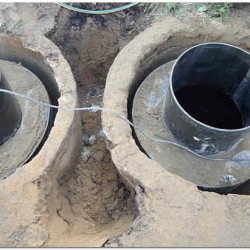 Exist different kinds waterproofing. Work on some methods require the involvement of special equipment. Some technologies are available only to professionals. There are waterproofing methods that are available for independent work. Regardless of the chosen method, it must be presented at least in general terms.
Exist different kinds waterproofing. Work on some methods require the involvement of special equipment. Some technologies are available only to professionals. There are waterproofing methods that are available for independent work. Regardless of the chosen method, it must be presented at least in general terms.
In the process of designing a septic tank, future owners often have a question: what shape and width should the pit be? The shape in this case is not important, it can be round, rectangular or irregular. Width is more important. The pit under the septic tank should allow not only to install reinforced concrete rings there. Should be planned extra space for further sealing and waterproofing works.
Types of waterproofing
They differ from each other in materials, processing methods and final cost.
Penetrating
Many experts recognize this method of protecting concrete as the best. It is carried out with the help of special chemical compositions. Special substances penetrate deep into the concrete body, fill all the voids and crystallize.
Penetrating waterproofing is known for its "smart" effect. With a decrease in humidity, crystallization decreases, with an increase, it accelerates. If a crack appears in the concrete, it will be filled with an insulating substance.
The disadvantages of the method are its high cost and laboriousness. The surface of concrete rings requires special preparation and pre-treatment. But the compositions for penetrating waterproofing perfectly fasten the seams between the rings.
Bituminous
 Processing with hot bitumen to impart moisture insulating properties to materials has been known for many decades. Now this method has only one plus - low cost. The bituminous coating is not resistant to freezing and thawing, it does not last long and soon begins to crack and flake off.
Processing with hot bitumen to impart moisture insulating properties to materials has been known for many decades. Now this method has only one plus - low cost. The bituminous coating is not resistant to freezing and thawing, it does not last long and soon begins to crack and flake off.
There is another option - specialized bituminous mastics. Special additives are introduced into their composition, which increase the durability of the coating and its service life. Another difference from conventional bitumen is that mastics are applied cold, which simplifies and speeds up the work.
Polymer cement
It is more expensive than bitumen, but cheaper than penetrating. Cement-based formulations with additives can be applied with a brush. It will take two layers, you don’t need to wait for the first to dry before applying the second (which means that the work will go pretty quickly).
clay castle
If on land plot or nearby there is an abundance of pure clay without admixture of sand, you can arrange a clay castle. The space around the concrete rings must be covered with clay with regular tamping.
This method cannot be carried out only external moisture protection. Usually a clay castle is made in addition to bituminous waterproofing.
Plaster
With the help of a special cement gun under high pressure two thick layers of non-shrinking cement are applied to the walls of the rings. In addition to special equipment, the process requires a lot of time. Cement layers should dry gradually, slowly, so they must be watered with water at intervals of three to twelve hours. The second layer is applied only "dry".
plastic
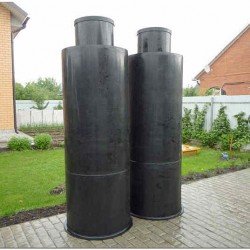 Waterproofing a concrete septic tank from the inside can be successfully performed using a special sealed insert. This special design made of plastic, which is reinforced with stiffeners and equipped with a hatch. It is recommended to fill the space between the insert and concrete rings with a mixture of sand and cement or fill it with concrete. A plastic insert in concrete rings for a septic tank lasts about thirty years.
Waterproofing a concrete septic tank from the inside can be successfully performed using a special sealed insert. This special design made of plastic, which is reinforced with stiffeners and equipped with a hatch. It is recommended to fill the space between the insert and concrete rings with a mixture of sand and cement or fill it with concrete. A plastic insert in concrete rings for a septic tank lasts about thirty years.
Sealing a septic tank, regardless of the method chosen, begins with the processing of seams. But even before carrying out moisture protection work at the joints of concrete rings, it is necessary to seal the joints. Without these works, even the best waterproofing technique will not give a full result.
Sealing
Inter-ring seams are the weak point of any septic tank. It is in this part of the tanks that the first leaks appear if the concrete rings for the septic tank are displaced. To prevent such an “accident”, concrete joints are sealed. Various methods have been developed for this:
- Applying rubber gaskets with bentonite granules to the places of future joints. The result is a plastic joint with a filling effect.
- Use of rubber sealing tape or reinforcing fabric. Provide high level sealing, but have a high cost. The reinforcing fabric must be exposed to ultraviolet radiation.
It is hardly possible country cottage area or imagine a house without a well thought out sewer system. In order to achieve the correct effective work systems, you need to build a special septic tank from concrete rings. There are no difficulties in erection, so you can make everything with your own hands without resorting to the help of specialists.
A septic tank is a design that provides purification and clarification of waste water. Previously, for such processes, it was built cesspool, but the service life and feature of the septic tank are much superior to the old options. The most common, although not the only materials are concrete rings. Waterproofing a septic tank is carried out using various materials.
Features of a concrete septic tank
The installation scheme is such that the rings are placed one on top of the other, which means that the resistance to the movement of groundwater or the soil itself remains minimal. You can use a monolithic septic tank, or connect the rings with ties (metal rings). The main disadvantage of a septic tank is the inevitable ingress of a small amount of waste into the ground. Leakage occurs because it is not possible to perfectly seal the circumferential joints.
The building elements are quite heavy, so inserting the elements with a crane will greatly facilitate the work, although their cost will increase.
Main scheme
The scheme of the septic tank from the rings is a certain number of wells connected to each other. The meaning of each of them:
- the first of the sections is a well with a concrete bottom. It should be connected to a pipe that removes all waste. The insertion of the pipe is carried out with a slight slope so that the waste is removed independently. The angle of the installed outlet is normal if there is 2 cm of slope for each meter of length.
The section serves to allow solidified waste to decompose well. The action is carried out because the waste contains anaerobic bacteria that can quickly decompose all masses. When a thick sediment occurs, liquid fractions begin to flow into the second tank section; - the second tank is made the same size as the first. Their devices are identical. This compartment is used for filtration. Here are materials that are responsible for its natural course (a small amount of gravel, expanded clay and similar substances);
- the next tank contains the filtered fraction. The received liquids from this compartment can be discharged into the ground in a natural way, or, for a more thorough removal, use forced removal using a pump. When removing liquids with a cesspool machine, the location of the third tank should be carried out in close proximity to the access routes.
Rubble pad
The main problem when installing septic tanks is soil heaving, that is, an increase in the size of the soil under the influence of various external factors. When installing a septic tank in places where the soil is very heaving, you need to build a belt of soil. Experts give recommendations on the choice of materials. The best for bedding is an expanded clay pillow, or materials with a similar composition.
The material is not so important, the main thing is to make a pillow before installing concrete rings. The pillow should be at least 30 cm thick. The rings should be fastened with metal bolts or staples. Seals are inserted so that due to heaving there are no shifts of the rings, and sealed places do not let the contents into the ground. A hatch should be made in each section so that access to the contents is easy.
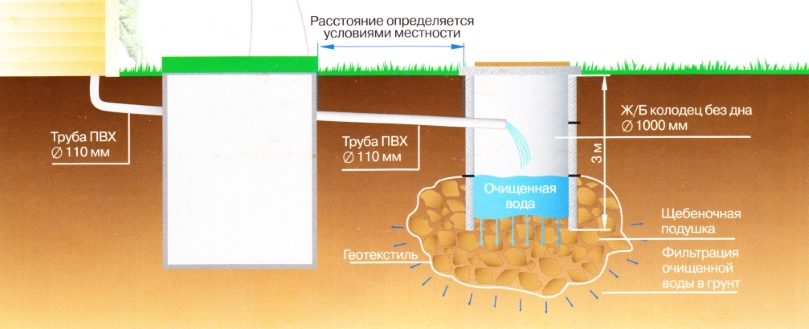 Photo: crushed stone pillow should be poured only if there is no bottom in the well
Photo: crushed stone pillow should be poured only if there is no bottom in the well Seam waterproofing
An important factor during the work is the insertion of insulating materials both from the inside and outside. Waterproofing is often insufficient because faecal water is not completely isolated. So special isolation is done with compounds that are designed for this. All surfaces should be insulated, because even such durable materials will be destroyed by waste. The process is called "concrete corrosion". If such processes begin, the septic tank will significantly reduce its service life.
 Photo: using bitumen in conjunction with a clay castle
Photo: using bitumen in conjunction with a clay castle Penetrating waterproofing
The waterproofing of the septic tank will be made as reliably as possible when using penetrating waterproofing. When processing the ring on both sides, the concrete is better protected, since the composition penetrates the entire thickness of the wall. There are now a great many mixtures for insulating the surface, for example, Penetron. Produced specifically for this type of work.
Even with good seam processing, the rings should be fixed as high as possible so that there is no displacement. The seams are being processed. Work is done when the rings are installed. You can use gaskets, but the elements are inserted into the cement mortar. Further, the manufacturer's instructions will tell you how to properly apply the composition to the surface, so you should use it.
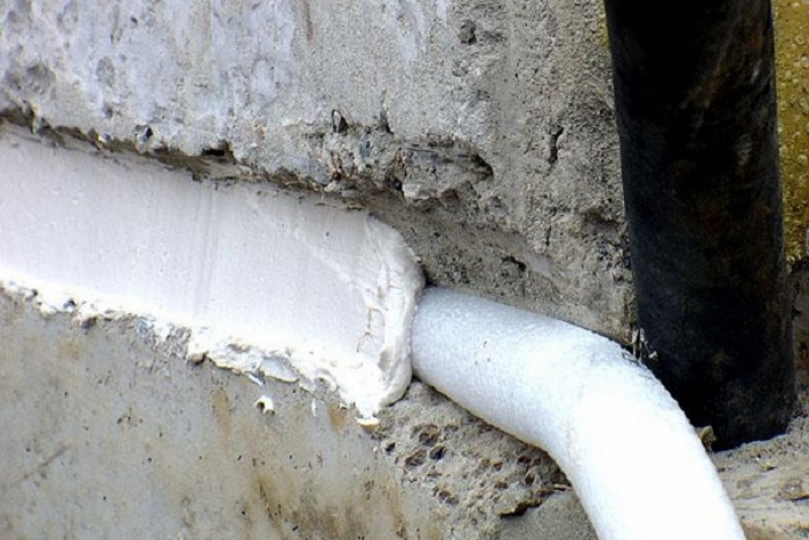 Photo: sealing seams with sealant
Photo: sealing seams with sealant bitumen insulation
The waterproofing of a septic tank made of concrete rings is carried out using bitumen, which, when hot, is an excellent insulation. The service life of the material is not very high, so it will soon begin to crack or flake, and it does not tolerate frost and thaw. It is better to use bituminous mastics, which contain many additives to improve properties. Serve such materials will be much longer. The mask should be applied cold. Such work does not cause difficulties, it is important to perform without skipping sections.
Polymer cement insulation
You can replace other types of insulation with cheaper ones. The main thing is that all places are airtight. One of these cheap types is polymer cement or coating cement. Such material will serve for a long time, compared with bitumen. It is easy to apply with a brush in two layers. The second layer must be applied immediately after the first, as soon as the fixing has begun. The "wet on wet" principle. Seam joints are treated with sealants.
clay castles
For insulation from the outside, you can use a clay castle. With this method, the well is filled with a pure clay composition, sand is not added. Then everything is rammed. It turns out that the access of groundwater to the bottom of the well is blocked. But using only this method will not be enough, it is better to use it in conjunction with others. The thickness of the clay layer should not be lower than 25 cm.
plastic pipes
Alternatively, you can take rare measures - use plastic rings for a septic tank. You can use barrels or plastic pipes for such purposes. Only there is little sense in such isolation, because it is easier to construct wells with these materials at once. The insulation will be strong, the most durable.
Conclusion
Whatever method of insulation of concrete structures is chosen, it is important to select it taking into account the environment, the purpose of the tanks. The work is carried out only with the highest quality, since if the performance is unsatisfactory, it will soon be necessary to do everything again.
Water supply, centralized or for private households, must be protected as much as possible from direct contact between drinking water and groundwater, the soil itself and the harmful chemicals it contains. The same protection is also provided for sewerage, but with the opposite purpose - so that wastewater and harmful chemical impurities do not penetrate into groundwater and do not enter drinking water sources. An excellent protection is the application of moisture-proof materials to the surface of concrete or metal pipes sewerage. For example, waterproofing a well from concrete rings is done using bitumen, bituminous mastics and other liquid compounds that do not allow water to pass through and do not adhere to it. Mastics are applied both from the inside and outside on the concrete ring, and each of these layers has its own purpose.
For sewer industrial and home-made tanks, the isolation of the system is a paramount parameter, since even a slight leakage of effluents into the ground pollutes the environment and nearby sources of drinking water, especially if this leakage goes unnoticed and exists for a long time.
Features of waterproofing
A sewer or water well made of concrete rings is a cheap and labor-intensive construction, so such wells are often built for the most different needs. Concrete is a durable material, but the material allows moisture to pass through in both directions, so the waterproofing of concrete rings is a mandatory measure in any case. Harmful is both the seepage of effluents into the ground and the ingress dirty water(precipitation, unfiltered groundwater, surface water flows) to a drinking water source. Waterproofing is applied in several layers, which achieves high isolation of different levels of water treatment and reliability of the system as a whole.
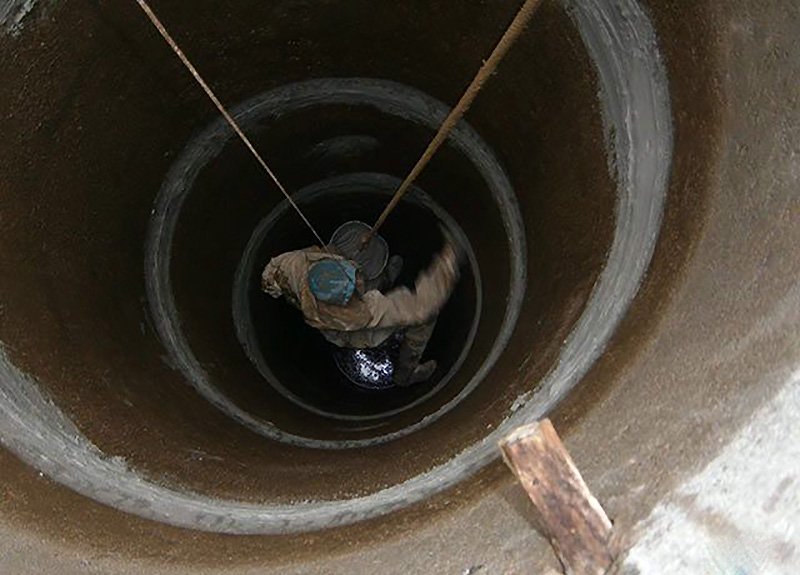
Work on the arrangement of waterproofing concrete wells can be divided into main and auxiliary. The main waterproofing of a septic tank from concrete rings is carried out immediately - during the construction of a concrete well, and not only the internal and external walls of the well are waterproofed - it is imperative to organize high-quality protection of the joints and seams at the joints of the well elements. If the well has already been built, then it is necessary to monitor the condition of the waterproofing, and update it as necessary. Waterproofing repair is carried out:
- A septic tank made of concrete rings began to quickly fill up with the same same water consumption by the residents of the house;
- Concrete rings have shifted relative to each other or cracks have appeared in the material;
- For a drinking well - if a fine suspension, dirt, visible specks appear in the water.
Each of these manifestations indicates water or environmental pollution, therefore, it can serve as a signal to urgently update the waterproofing layers and seal the joints and seams from the outside and from the inside.
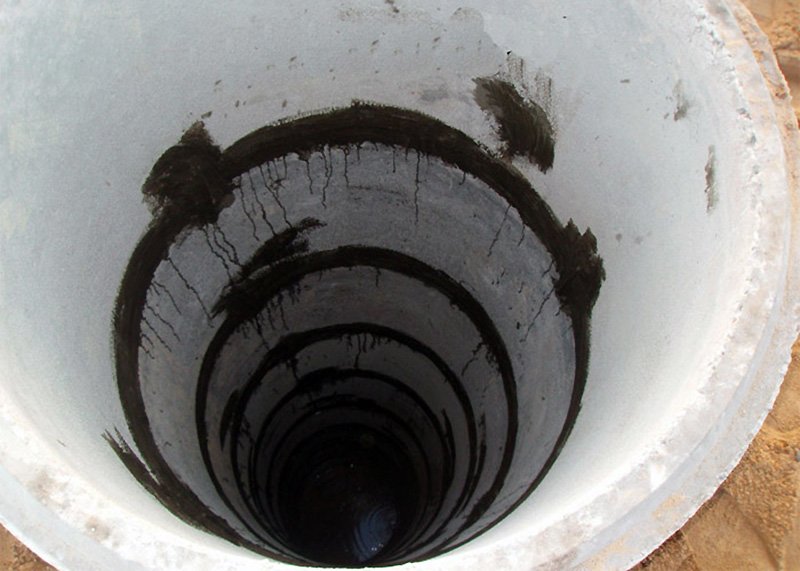
Waterproofing materials
The functional purpose of a concrete structure made of rings determines how it should be protected from external or internal moisture. There are few methods - this is waterproofing of all concrete surfaces, and protection of seams and joints from moisture penetration by sealing, coating or other solutions.
To create a moisture-proof layer on the entire surface of the concrete, coating materials are used - mastics, adhesives, cement-based compositions. For waterproofing seams, technological holes, joints, cracks are used adhesive compositions with hydrophobic additives.
Innovative technologies offer a method of spraying special compositions based on mineral mixtures onto concrete. Thus, any surface - with cracks, seams or damage - becomes monolithic thanks to a new monolithic surface layer. Special waterproofing membranes also provide long-term protection concrete surfaces from moisture penetration from both sides.
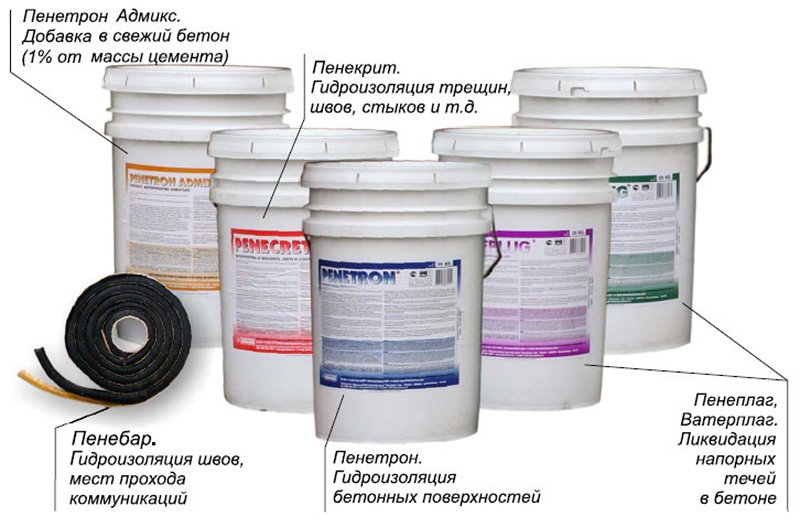
Coating compositions and roll materials
Bituminous (tar) mastics have been known for a long time, and are considered not only the simplest and cheapest way to protect concrete from moisture, but also the most common and versatile method that can be used for almost all concrete structures, and not just for concrete rings in wells.
The next most popular are liquid rubber, polymeric liquid substances and composite materials - they are more often used to protect concrete from the outside so that synthetics have less contact with drinking water. For sewer wells such protection can be used both outside and on internal surfaces. Waterproofing works with such substances are carried out with the application of several layers and using a reinforcing fiberglass mesh.
Bitumen-based mastics, as well as paints and varnishes and formulations based on liquid rubber after hardening, they seal not only the seams and joints of structural elements, but also the entire protected surface of the concrete ring.
Soft-based rolled waterproofing materials also fit well on the concave or convex surface of the concrete ring, therefore they are used to protect wells both outside and inside. Such materials are fastened or with the help of special adhesives, or in combination with the use of bituminous mastics. Special skills in working with such materials are not required, therefore, for the private sector, this is a fairly popular solution that ensures the proper quality and durability of protection.
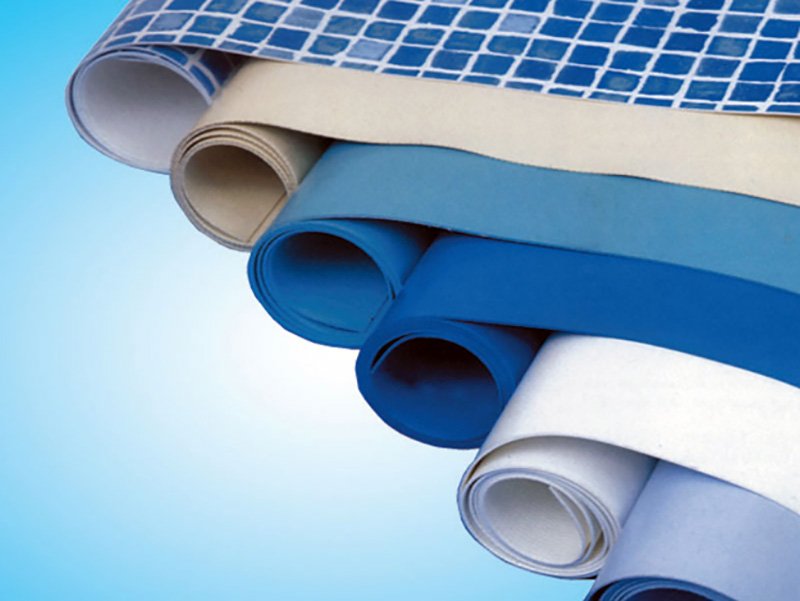
Membrane polymeric materials
Membrane waterproofing is a synthetic material with limited moisture permeability. On such membrane films there is an adhesive surface layer with which the membrane is attached to the protected surface. The membrane film does not allow moisture to seep into the concrete rings of a sewer or water well, protecting not only the seams and joints, but the entire surface without exception.
A greater and more reliable effect can be achieved by using a combination of membrane films and polymer mastics- so the surface, inaccessible to the penetration of moisture, will certainly be solid and dense - after all, the film can be easily damaged during fastening or during operation.
Mineral waterproofing mixtures
Such mixtures are applied using special equipment that supplies mass to concrete with high pressure. Application under pressure allows you to fill all the pores, dents, cracks, joints and seams of concrete, creating an absolutely monolithic and moisture-proof layer.
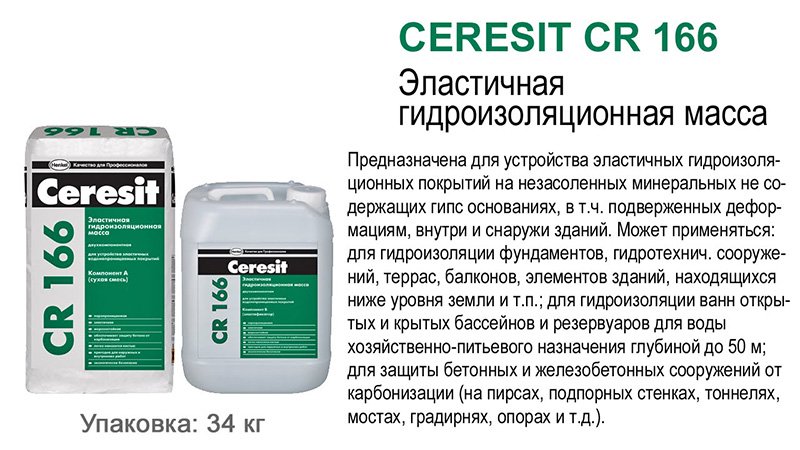
This technology for applying waterproofing and sealing the surface of a concrete well from rings is used for all surfaces - both internal and external. The main advantage of such mixtures is that the surface treated with this method does not need to be additionally protected, since the hardened layer is mechanically strong and absolutely impervious to moisture. And in order to exclude even the minimum diffusion of the waterproofing agent into the water during protection internal surfaces concrete ring, the layer can be top-coated with mineral paint or membrane film.
Before you start applying, fixing or laying waterproofing on the walls of a concrete well, the surface must be prepared. The preparation consists in cleaning the concrete from dirt and dust, sealing the joints and seams with a solution of well cement, and plastering especially uneven areas. Then the well must be dried naturally, after which, for a particular design, choose the most suitable way waterproofing and implement it. The most reliable methods of protection against moisture in private conditions are coatings and protection with a membrane film.
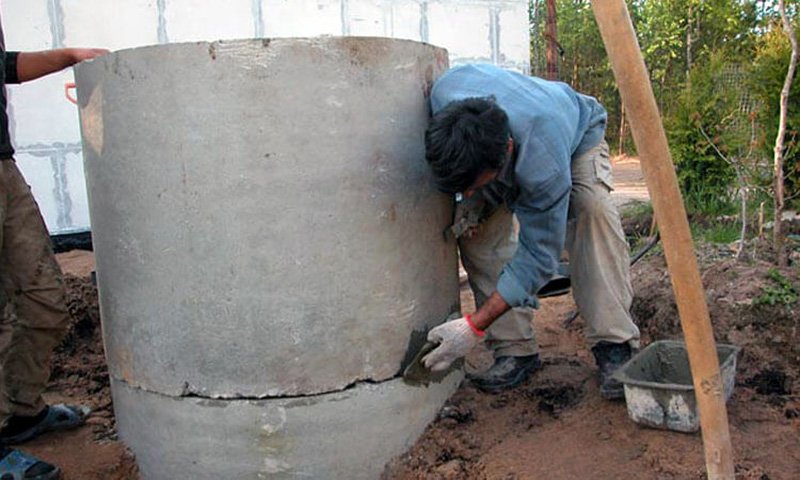
After the well has dried, all old protective layers, if any, must be removed, and for better diffusion of liquid waterproofing materials, all surfaces of the tank are covered with a deep penetration primer with water-repellent properties. The joints of the rings are primed several times, as well as waterproofing materials are applied several times, as these are high-risk areas.
How to apply waterproofing composite materials
The coating may be based on bitumen or synthetic composite materials, and is most often heated before application. But any coating must be laid in 2-3 and even 4 layers, laying a reinforcing belt made of polyester fiber between the layers. For the first bitumen-based coating composition, four volume parts of any solvent based on gasoline or mineral spirits are added to one part of the mixture. The mastic is applied with a roller or a wide brush, you can also use a pneumatic sprayer, but it will take a lot of the same white spirit to wash it.
A few hours after applying the first layer bituminous mastic a reinforcing fabric is attached to the frozen surface (it is simply glued to the bitumen), and the next layer of mastic is applied, but without diluting the bitumen with solvents. The second solution will be viscous, so it is preheated and applied with a wide spatula on a long handle. Since both layers consist of the same components, the diffusion will be quite deep, and the use of reinforcing polyester will additionally hold both layers together. The second layer must be smoothed until it is completely hardened with a special spiked roller in order to release air from a viscous and dense substance.

Membrane films are produced with a primary layer of glue, so there is no need to use additional compounds for their fastening. The membrane is attached to the second layer of bitumen after complete cooling and hardening of the mastic - in about a day.
Seams and joints of concrete rings are processed waterproofing materials before the entire surface is treated, and then together with the general protection. After laying the rings on top of each other, the joints are first poured cement-sand mortar, in which liquid glass or water-repellent additives are added for moisture resistance. The proportions of the solution are standard, 1: 3, liquid glass add 1-2%, water repellent - 0.1%. Holes for sewer or water pipes are covered with waterproofing last.
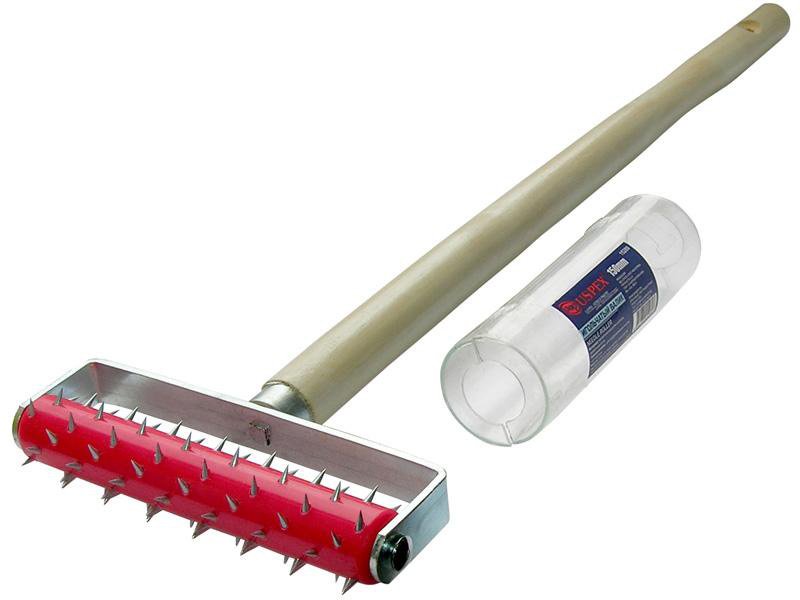
concrete wells intended for waste or sewage water, are also protected at their base, which is usually made from a flat ring or concrete slab. It is important to seal and waterproof the joints at the junction of the first (lower) ring and the slab in the same way as the rest of the well surface in order to prevent mutual penetration of groundwater and sewage.








